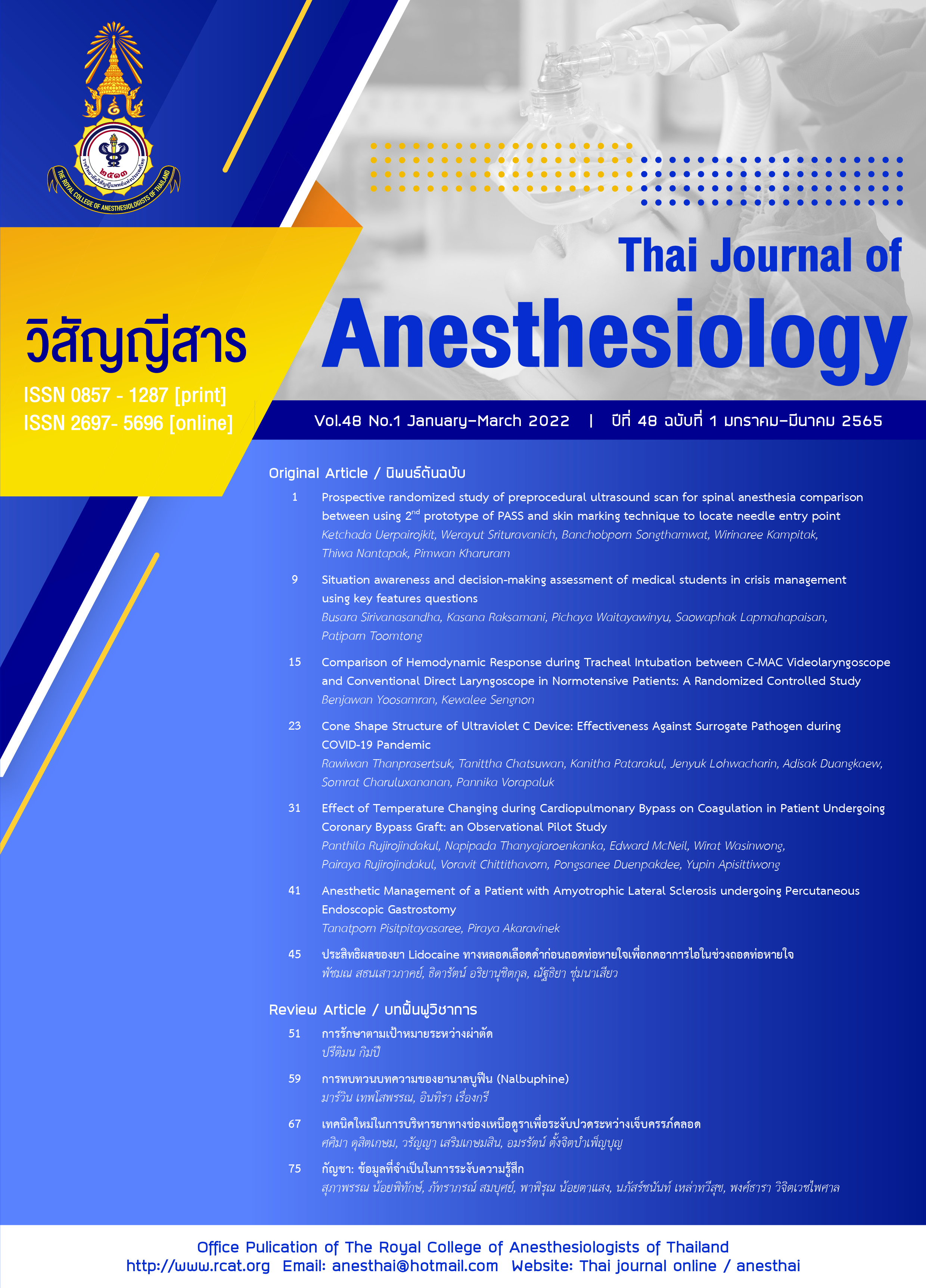Perioperative Goal-directed Therapy
Main Article Content
Abstract
Currently, the number of high risk patients undergoing high risk surgery is increased which result in higher perioperative mortality and morbidity rate. Close hemodynamic monitoring in intensive care unit is needed to improve their survival rate and reduce perioperative complications. Perioperative goal-directed therapy is one of the hemodynamic optimization approach during perioperative periods with several available specific goals to be chosen such as oxygen delivery or parameters derived from cardiac function curve. Based on a narrative review, the terms about perioperative goal-directed therapy were searched for English language before January 2021. As a result, mortality rate is significantly decreased in high risk patients. Reduced complication rate can be expected in all patients. Because of high variation of different goals, number of patients and types of surgery, the decision of chosen goal is depend on potential of each hospital and attending physician.
Article Details

This work is licensed under a Creative Commons Attribution-NonCommercial-NoDerivatives 4.0 International License.
References
Marik PE. Perioperative hemodynamic optimization: a revised approach. J Clin Anesth. 2014;26(6):500-5.
Pearse RM, Moreno RP, Bauer P, et al. Mortality after surgery in Europe: a 7 day cohort study. Lancet. 2012;380(9847):1059-65.
Shoemaker WC, Appel PL, Bland R, Hopkins JA, Chang P. Clinical trial of an algorithm for outcome prediction in acute circulatory failure. Crit Care Med. 1982;10(6):390-7.
Shoemaker WC, Appel PL, Kram HB, Waxman K, Lee TS. Prospective trial of supranormal values of survivors as therapeutic goals in high-risk surgical patients. Chest. 1988;94(6):1176-86.
Boyd O, Grounds RM, Bennett ED. A randomized clinical trial of the effect of deliberate perioperative increase of oxygen delivery on mortality in high-risk surgical patients. JAMA. 1993;270(22):2699-707.
Ueno S, Tanabe G, Yamada H, et al. Response of patients with cirrhosis who have undergone partial hepatectomy to treatment aimed at achieving supranormal oxygen delivery and consumption. Surgery. 1998;123(3):278-86.
Hofer CK, Cannesson M. Monitoring fluid responsiveness. Acta Anaesthesiol Taiwan. 2011;49(2):59-65.
Conway DH, Mayall R, Abdul-Latif MS, Gilligan S, Tackaberry C. Randomised controlled trial investigating the influence of intravenous fluid titration using oesophageal doppler monitoring during bowel surgery. Anaesthesia. 2002;57(9):845-9.
Venn R, Steele A, Richardson P, Poloniecki J, Grounds M, Newman P. Randomized controlled trial to investigate influence of the fluid challenge on duration of hospital stay and perioperative morbidity in patients with hip fractures. Br J Anaesth. 2002;88(1):65-71.
Noblett SE, Snowden CP, Shenton BK, Horgan AF. Randomized clinical trial assessing the effect of doppler-optimized fluid management on outcome after elective colorectal resection. Br J Surg. 2006;93(9):1069-76.
Scheeren TWL, Wiesenack C, Gerlach H, Marx G. Goal-directed intraoperative fluid therapy guided by stroke volume and its variation in high-risk surgical patients: a prospective randomized multicentre study. J Clin Monit Comput. 2013;27(3):225-33.
Correa-Gallego C, Tan KS, Arslan-Carlon V, et al. Goal-directed fluid therapy using stroke volume variation for resuscitation after low central venous pressure-assisted liver resection: a randomized clinical trial. J Am Coll Surg. 2015;221(2):591-601.
The UK Perioperative Medicine Clinical Trials Network. Fluid optimisation in emergency laparotomy (FLO-ELA) trial [Internet]. [Cited on 1 June 2021]. Available form: http://www.floela.org/.
Pearse RM, Harrison DA, MacDonald N, et al. Effect of a perioperative, cardiac output-guided hemodynamic therapy algorithm on outcomes following major gastrointestinal surgery: a randomized clinical trial and systematic review. JAMA. 2014;311(21):2181-90.
Edwards MR, Forbes G, MacDonald N, et al. Optimisation of perioperative cardiovascular management
to improve surgical outcome II (OPTIMISE II) trial: study protocol for a multicentre international trial of cardiac output-guided fluid therapy with low-dose inotrope infusion compared with usual care in patients undergoing major elective gastrointestinal surgery. BMJ Open. 2019;9(1):e023455.
Cecconi M, Corredor C, Arulkumaran N, et al. Clinical review: goal-directed therapy–what is the evidence in surgical patients? The effect on different risk groups. Critical Care. 2013;17(2):209.
Evans DC, Doraiswamy VA, Prosciak MP, et al. Complications associated with pulmonary artery catheters: a comprehensive clinical review. Scand J Surg. 2009;98(4):199-208.
Kristensen SD, Knuuti J, Saraste A, et al. ESC/ESA guidelines on non-cardiac surgery: cardiovascular assessment and management. Eur Heart J. 2014;35:2383-431.
Chong MA, Wang Y, Berbenetz NM, et al. Does goal-directed haemodynamic and fluid therapy improve peri-operative outcomes?: a systematic review and meta-analysis. Eur J Anaesthesiol. 2018;35(7):469-83.
Grocott MP, Dushianthan A, Hamilton MA, Mythen MG, Harrison D, Rowan K. Optimisation systematic review steering group. Perioperative increase in global blood flow to explicit defined goals and outcomes following surgery. Cochrane Database Syst Rev. 2012;11:CD004082.
Michard F, Giglio MT, Brienza N. Perioperative goal-directed therapy with uncalibrated pulse contour methods: impact on fluid management and postoperative outcome. Br J Anaesth. 2017;119(1):22-30.
Sun Y, Chai F, Pan C, Romeiser JL, Gan TJ. Effect of perioperative goal-directed hemodynamic therapy on postoperative recovery following major abdominal surgery-a systematic review and meta-analysis of randomized controlled trials. Crit Care. 2017;21(1):141.
Benes J, Pradl R, Chytra I. Perioperative hemodynamic optimization: A way to individual goals. In: Vincent JL, editor. Annual update in intensive care and emergency medicine. Berlin: Springer; 2012. p 357-67.
Brandstrup B, Tønnesen H, Beier-Holgersen R, et al. Effects of intravenous fluid restriction on postoperative complications: comparison of two perioperative fluid regimens: a randomized assessor-blinded multicenter trial. Ann Surg. 2003;238(5):641-8.
Brandstrup B, Svendsen PE, Rasmussen M, et al. Which goal for fluid therapy during colorectal
surgery is followed by the best outcome: near-maximal stroke volume or zero fluid balance? Br J Anaesth. 2012;109(2):191-9.


